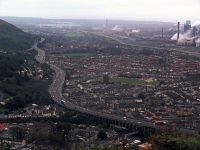Port Talbot (/ˌpɔːrt ˈtɔːlbət/, UK also /pɔːr-, pə-, -ˈtalbət, -ˈtɒlbət/) is a town and community in the county borough of Neath Port Talbot, Wales, situated on the east side of Swansea Bay, approximately eight miles (thirteen kilometres) from Swansea. The Port Talbot Steelworks covers a large area of land which dominates the south east of the town and is one of the biggest steelworks in the world but has been under threat of closure since the 1980s. The population was 37,276 in 2011.
History
Modern Port Talbot is a town formed from the merging of multiple villages, including Baglan, Margam, and Aberafan. The name 'Port Talbot' first appears in 1837 as the name of the new docks built on the south-east side of the river Afan by the Talbot family. Over time it came to be applied to the whole of the emerging conurbation.
The earliest evidence of humans in the Port Talbot area has been found on the side of Mynydd Margam where Bronze Age farming ditches can be found from 4,000 BC. There were Iron Age hill forts on Mynydd Dinas, Mynydd Margam, Mynydd Emroch and other nearby hills. Mynydd Hawdef contains remains of an ancient Iron Age village. The Margam deer herd was first introduced by the Romans.
Ffynnon Pedr is a holy well which flows from the hillside through a 16 in × 16 in (400 mm × 400 mm) stone culvert in Margam. This may have been a water supply for Margam Abbey, 1⁄2 mile (800 metres) to the east.
The Cross of Brancuf an early Christian Sculptured Stone which stands in the church of St Catharine at Baglan. It is an intricately sculptured cross-slab with a Latin cross and an inscription recalling Brancuf. Originally it stood in the old St Baglan's church but that fell into ruin in the late 19th century and the slab was removed to St Catharine's. St Baglan (Bagelan), son of King Ithael Hoel of Brittany, was a 6th-century hermit and follower of St Illtud. He founded the first church at the town that now takes his name. In the vestry of St Ca
